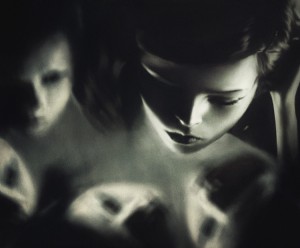 This blog was originally posted on December 12, 2010, but I decided to repost it with some added recipes at the end. Enjoy!
This blog was originally posted on December 12, 2010, but I decided to repost it with some added recipes at the end. Enjoy!
All of my childhood Christmases were filled with cookies from my grandmother. She brought up her family on a farm in postwar Missouri. That farm had been in her husband’s family since 1850 and every generation of Jewett children were raised in the same house – my mother being the last. As with all postwar wives, my grandmother spent her early marriage cooking, cleaning, raising children and working around the farm. In the 1950s, she got a new cookie press made by a company called Mirro. The press came with a booklet of recipes and two of those recipes in particular became a big hit in our family. Soon she was expected to bring out the cookie press every Christmas season and the tradition carried on for the next fifty years. She kept the same cookie press all those decades, even when it was held together with masking tape. One year we got her a new press made of plastic and it broke the first year. Things just aren’t made to last anymore.
 Here are two recipes that have been part of the Jewett Christmas since the 1950s. Debates rage every year as to whether the wreaths or the trees are better but everybody seems to eat them by the fistful. They are so addictive that I advise people to just double or triple the recipes right away or you’ll be in the kitchen every week making more.
Here are two recipes that have been part of the Jewett Christmas since the 1950s. Debates rage every year as to whether the wreaths or the trees are better but everybody seems to eat them by the fistful. They are so addictive that I advise people to just double or triple the recipes right away or you’ll be in the kitchen every week making more.HOLLY WREATHS
1/2 cup butter
1/2 (3 oz.) pkg. cream cheese
1/4 cup sugar
1/2 tsp. vanilla
1 cup sifted all-purpose flour
Preheat oven to 375 degrees F. Cream butter, cream cheese and sugar well. Beat in vanilla. Gradually blend in flour. Fill cookie press. Form cookies on ungreased cookie sheets using star plate #2. Hold press in semi-horizontal position and form wreaths by moving press in a circular motion. Gently push ends of dough together to form wreaths. Bake 8-10 minutes. Remove at once to cooling racks. Yield: 2 dozen.
CHRISTMAS TREES
1 cup shortening
3/4 cup sugar
1 egg, beaten
1 teaspoon almond extract
green food coloring
2 1/4 cup sifted all-purpose flour
1/8 teaspoon salt
1/4 teaspoon baking powder
Cream the shortening and add sugar gradually. Add the egg and almond extract and beat the mixture very well. (Stir in green food coloring a drop at a time until the desired color.) Sift flour, baking powder and salt and gradually add to the first mixture. Stir until blended well. Fill a MIRRO Cookie press. Form cookies in desired shapes onto ungreased cookie sheets, decorate with candies and bake at 375 degrees F for 10-12 minutes.
November 24, 2012 UPDATE
When I was a little girl, my grandmother was heavily into baking and, like the cookies above, the other cookies she made were from recipes that were about a zillion years old. I’ve tried to find them but I fear they may have been lost to the flood this past summer. I remember her recipe book being filled with brittle old yellow pages with handwritten notes by my great grandparents and great great grandparents. Some were introduced to the family in the 60s or 70s, like the Hershey kiss cookies, but others, like the shortbread cookies or the Russian tea cookies, were from the nineteenth century. I can’t eat peanut butter, so the recipe is not accurate to what I ate, but I think my grandmother used either shortbread dough or sugar cookie dough.
48 Hershey kisses
1/2 cup shortening
3/4 cup creamy peanut butter
1/3 cup granulated sugar
1/3 cup packed light brown sugar
1 egg
2 tablespoons milk
1 teaspoon vanilla extract
1-1/2 cups all-purpose flour
1 teaspoon baking soda
1/2 teaspoon salt
Additional granulated sugar
Heat oven to 375°F. Remove wrappers from chocolates. Beat shortening and peanut butter in large bowl until well blended. Add 1/3 cup granulated sugar and brown sugar; beat until fluffy. Add egg, milk and vanilla; beat well. Stir together flour, baking soda and salt; gradually beat into peanut butter mixture. Shape dough into 1-inch balls. Roll in granulated sugar; place on ungreased cookie sheet. Bake 8 to 10 minutes or until lightly browned. Immediately press a chocolate into center of each cookie; cookie will crack around edges. Remove from cookie sheet to wire rack. Cool completely. About 4 dozen cookies.
1 cup butter softened
1/2 cup powdered sugar for dough + 1/2 cup for rolling
1+1/2 tsp vanilla
2 cups flour
1 dash salt
1/2 tsp baking powder
3/4 cup finely chopped pecans or walnuts
In a bowl, beat together the butter and 1/2 cup powdered sugar and vanilla until smooth and creamy. Mix together flour, salt, and baking powder. Add to bowl and mix until blended well. Add chopped nuts and mix well. Using hand, knead and roll the dough out into 2 balls. Wrap tightly in plastic wrap and chill in refrigerator for at least 1 hour. Take balls out of refrigerator and flatten out and cut into approximately 20 equal sized pieces to get total of 40 cookies. Shape into marble-sized balls and place on ungreased cookie sheet. Bake at 375C for 10 mins until firm but not browned. (The bottoms inevitably become little browned but that is okay.) Roll in powdered sugar when still warm. Let cool and roll in powdered sugar again.
3 cups flour
2 cups unsalted butter
1 cup caster/confectioners/icing sugar
¼ to ½ tsp. salt
1 tsp. vanilla (optional, you can also use nutmeg, cinnamon, ginger, rum or lemon rind)
2 tbsp. cool water
Preheat the oven to 350 degrees F. Add sugar, salt and flour(s) in a bowl and mix well. Cut in butter until your mixture resembles crumbs. Cut the butter in using two knives across the flour mixture, until it resembles beans, or use your fingers to mix it in. When the flour, sugar and butter mixture is crumbly, like peas, add 1 to 2 tbsp. of water and knead it in–just enough to create a cakey, but not gummy, dough. If the dough is gummy or gluey, your cookies will be hard. Add the vanilla, or any combination of flavoring, including orange rind.
Your dough can be shaped into many varieties. Popular shapes include hearts, discs and classic rectangles. To shape into hearts or squares, use a cookie cutter in your desired shape. Lightly flour a cutting board and roll out dough that’s about ½ inch thick. Cut the dough into your desired shape. Place cookies on a lightly buttered cookie sheet and bake for about 12 minutes. Take the shortbread cookies out of the oven when they’re golden. For the classic rectangle shape, press dough into a shallow rectangular baking tin, and use a knife to gently divide the dough into small, even rectangles. Use a fork to poke holes all over. Bake for about 12 minutes, or until golden brown. Let the cookies cool before serving.
Read More



















